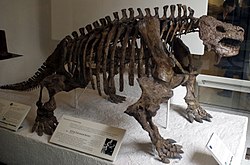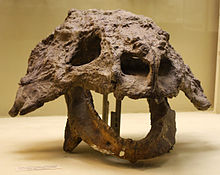Scutosaurus: Difference between revisions
m r2.7.1) (Robot: Adding sv:Scutosaurus |
No edit summary |
||
| Line 31: | Line 31: | ||
''Scutosaurus'' was shown in the ''[[Walking with Monsters]]'' series as being a social animal that migrated in groups. ''Scutosaurus'' was depicted as being the main prey of a large [[Gorgonopsia|gorgonopsid]], later erroneously identified in the books as ''[[Gorgonops]]''. It was highly unlikely that ''Gorgonops'' preyed on these beasts, as it was indigenous to the region in [[Gondwana]] that is now South Africa, while ''Scutosaurus'' was indigenous to the region in [[Laurasia]] that is now Siberia. However, it is possible that related animals, such as the Russian ''[[Inostrancevia]]'', may have preyed on ''Scutosaurus''. |
''Scutosaurus'' was shown in the ''[[Walking with Monsters]]'' series as being a social animal that migrated in groups. ''Scutosaurus'' was depicted as being the main prey of a large [[Gorgonopsia|gorgonopsid]], later erroneously identified in the books as ''[[Gorgonops]]''. It was highly unlikely that ''Gorgonops'' preyed on these beasts, as it was indigenous to the region in [[Gondwana]] that is now South Africa, while ''Scutosaurus'' was indigenous to the region in [[Laurasia]] that is now Siberia. However, it is possible that related animals, such as the Russian ''[[Inostrancevia]]'', may have preyed on ''Scutosaurus''. |
||
''Scutosaurus'' was also shown in the ''[[Primeval (TV series)|Primeval]]'' series. |
''Scutosaurus'' was also shown in the ''[[Primeval (TV series)|Primeval]]'' series, but increased to the size of an elephant for dramatic reasons. |
||
== References == |
== References == |
||
Revision as of 20:21, 16 October 2012
| Scutosaurus Temporal range: Changhsingian,
| |
|---|---|

| |
| Skeleton, American Museum of Natural History | |
| Scientific classification | |
| Kingdom: | |
| Phylum: | |
| Class: | |
| Subclass: | |
| Order: | |
| Family: | |
| Genus: | Scutosaurus Hartmann-Weinberg, 1930
|
Scutosaurus ("Shield Reptile") was a genus of armor-covered pareiasaur that lived around 252-248 million years ago in Russia, in the later Permian period. Its genus name refers to large plates of armor scattered across its body. It was a large anapsid reptile that, unlike most reptiles, held its legs underneath its body to support its great weight.[1]
Palaeobiology


Scutosaurus was a massively built reptile, up to 2.5 metres (8.2 ft) in length, with bony armor, and a number of spikes decorating its skull.[1] Despite its relatively small size, Scutosaurus was heavy, and its short legs meant that it could not move at speed for long periods of time, which made it vulnerable to attack by large predators. To defend itself Scutosaurus had a thick skeleton covered with powerful muscles, especially in the neck region. Underneath the skin were rows of hard, bony plates (scutes) that acted like a form of chain mail.
As a plant-eater living in a semi-arid climate, Scutosaurus would have wandered widely in order find fresh foliage to eat. It may have stuck closely to the riverbanks and floodplains where plant life would have been more abundant, straying further afield only during times of drought. Its teeth were flattened and could grind away at the leaves and young branches before digesting them at length in its large gut. Given that it needed to eat constantly, Scutosaurus probably lived alone, or in very small herds, so as to avoid denuding large areas of their edible plants.
With its large cheekbones, Scutosaurus may have been able to make a loud bellowing sound. It had excellent hearing and could have heard other animals bellowing from some distance away. These noises could have been used for mating or as warning signals.[citation needed]
In popular culture

Scutosaurus was shown in the Walking with Monsters series as being a social animal that migrated in groups. Scutosaurus was depicted as being the main prey of a large gorgonopsid, later erroneously identified in the books as Gorgonops. It was highly unlikely that Gorgonops preyed on these beasts, as it was indigenous to the region in Gondwana that is now South Africa, while Scutosaurus was indigenous to the region in Laurasia that is now Siberia. However, it is possible that related animals, such as the Russian Inostrancevia, may have preyed on Scutosaurus.
Scutosaurus was also shown in the Primeval series, but increased to the size of an elephant for dramatic reasons.
References
- ^ a b Palmer, D., ed. (1999). The Marshall Illustrated Encyclopedia of Dinosaurs and Prehistoric Animals. London: Marshall Editions. p. 64. ISBN 1-84028-152-9.
- Haines, Tim, and Paul Chambers. The Complete Guide to Prehistoric Life. Pg. 46-47. Canada: Firefly Books Ltd., 2006
